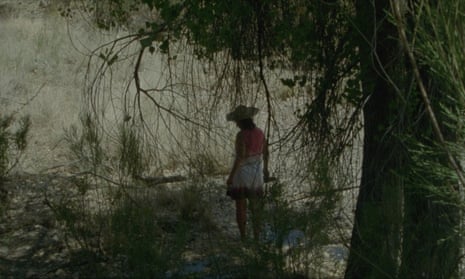The Sonoran desert is a piece of the American landscape that has evolved as if to edit humanity out of existence. Populated by spiked plants, poisonous insects, rattlesnakes and one of America’s few native big cats, the jaguar, its arid terrain stretches along the US-Mexican border over a total of 260,000 sq km.
Crossing this wildnerness on foot takes three to five days, and during the summer, daytime temperatures regularly exceed 40°C (104°F). The US border patrol is alleged to have retrieved 6,029 human remains from this stretch in southern Arizona since the 1990s. The bodies of thousands of others who have tried to enter the US through the desert may have been bleached away by the searing sun before they were found.
For El Mar La Mar, which premiered at the Berlin film festival this week, film-makers Joshua Bonnetta and JP Sniadecki visited this hostile environment for lengthy spells over the course of almost three years, filming the landscape, recording wildlife and talking to border rangers, aid workers and people-smugglers.
Though their project started more than a year before the American electorate was lured by the promise of a “great, great wall” on its southern border, the result is a nature-documentary-cum-film-poem that also works as a sarcastic riposte to the new president’s grand plan: how could anyone artificially design a more mercilessly efficient deathtrap than the Sonoran desert in its current form?
Sniadecki, a graduate of Harvard’s increasingly influential Sensory Ethnography Lab, says he and Bonnetta became interested in the politics of the Sonoran after a chance encounter with a border guard on a dirt track near the desert, which in turn led them to a book, The Land of Open Graves, by the anthropologist Jason De León.

The arid borderlands of Arizona have been politicised for far longer than the Trump campaign: in 1994, the US government adopted an “enforcement through deterrence” strategy that involved building fences and increasing drone surveillance in the areas around official ports of entry, such as El Paso and Tijuana, while leaving open swaths of hazardous hinterland. Of the around 1,900-mile (3,100km) border between American and Mexico, 650 miles already has some kind of barrier in place.
“It funnels people through the desert,” says Bonnetta. “The signs and policy are designed to make it seem as if migrants crossing are taking their lives into their own hands.”
“It bears much resemblance to the [refugee] crisis in the EU. The desert, much like the sea, is used to deter and in some cases erase. The policy tries to place the blame on individual volition and shift the burden of responsibility for these unfortunate tragedies.”
Bonnetta and Sniadecki recorded their interviews only on audio. They are played back over shots of brutal landscape or complete darkness, rendering the stories even more harrowing. There are tales of migrants losing their bearing after being scattered by border patrols and wandering in circles for seven days. One farmer recalls seeing a man burned black from wildfire, still walking. Two brothers break down in exhausted sobs as they explain that they had to leave behind weaker members of their group.
Using contact microphones, the pair also created a soundtrack that often consists of little more than crackled telecommunications between border patrols, the whistle of sandy gales or the eerie rustle of plants.
At a Berlin festival in which directors have this year fallen over themselves to affirm their political stance, Bonnetta and Sniadecki’s film stands out because it allows one of the most politicised terrains in the world to speak for itself.

Comments (…)
Sign in or create your Guardian account to join the discussion